Recruiting Coordination | Talent Trends Report
33 minute read
Topics
Table Of Contents
For a long time, recruiting coordination roles have been a rite of passage for many recruiters. With changes in market conditions, automation taking shape in the industry, and new perspectives on work-life balance, we’re seeing a number of shifts take place.
Some recruiting coordinators (or RCs) have chosen to stay RCs over the switch to recruiter; others have evolved into roles within recruiting operations. Some teams have moved away from RCs in their organizational charts altogether, opting instead for fullstack recruiters. And sprinkled through it all are technology advancements that have made the workload that once squarely sat in recruiting coordination more efficient, and potentially even more enjoyable.
In this report, we map out the intricate world of recruiting coordination, take a sharp look at how it’s evolving, and use proprietary ATS data to understand trends, benchmarks, and explore where automation is driving innovative productivity gains.
The data pulled in this specific report is based on interview scheduling for over 2.8M candidates who get at least one interview for over 5.1M interview events. Subscribe to our Talent Trends newsletter to receive a PDF copy and bite-sized insight in your inbox every week.
Report Highlights:
- Talent teams at organizations with 500-10,000+ employees are getting leaner with the number of coordinators on the team while the work remains roughly the same.
- Scheduling interviews through Ashby can be done, on average, 40% sooner than scheduling through legacy ATS systems.
- Average submission rates for scorecards were between 84 to 89%, with the majority of feedback being submitted within two hours.
- The largest opportunity for faster coordination is in the time between when the events are scheduled and when the first event begins.
We’ll go into further detail of these insights and more throughout this report; simultaneously, we’ll seek to better scope the vast and multi-layered world of recruiting coordination.
We also share tips for improving efficiency throughout, primarily from recruiting coordinators we spoke with who rank among the fastest to schedule their interviews in our analysis. They’ll be marked with “🕒Efficiency Tip.”
Part 1: Defining Recruiting Coordination
Traditional definitions of recruiting coordinator roles often mention “managing the end-to-end hiring process.” We find this to be vague and often not in line with how different teams operate. While the bulk of this report is our own quantitative and qualitative data findings specific to scheduling and scorecards, an initial review of 50 different recruiting coordinator job descriptions yielded which skills or criterion are mentioned most often. The results from those open positions:
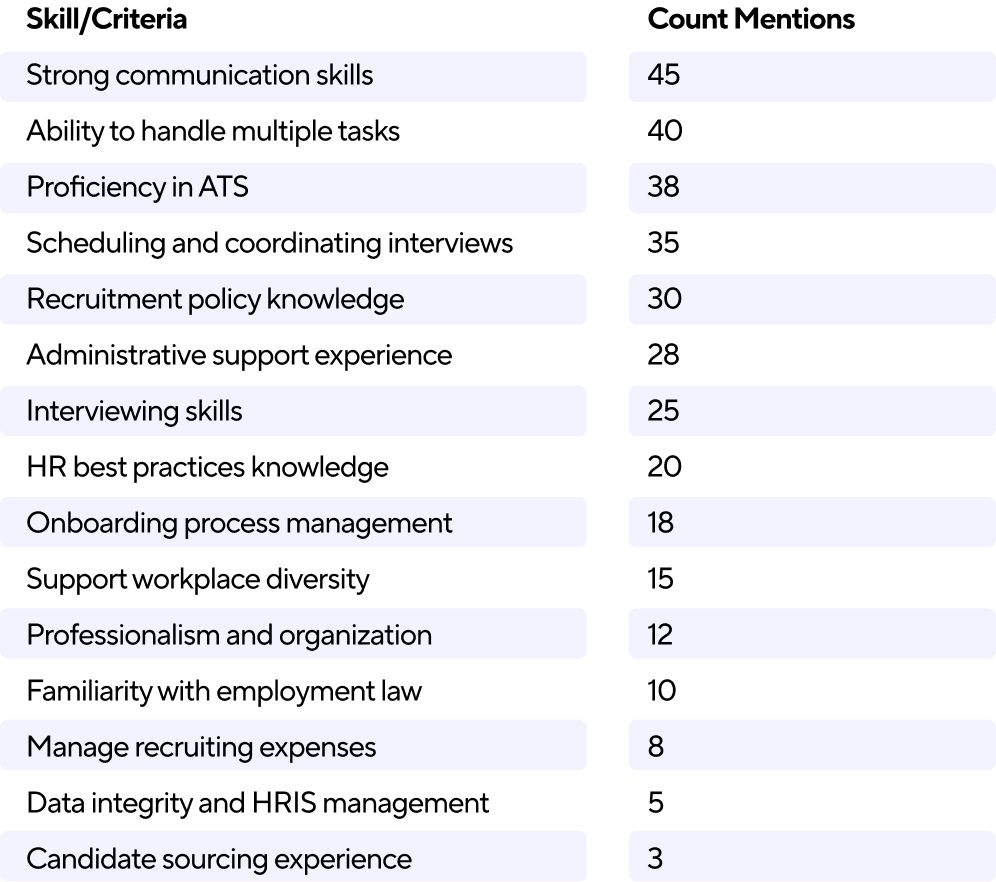
Volume of Recruiting Coordinators per Organization Took a Steep Drop Starting in 2022
Through our direct conversations with differing talent teams, it seems organizations today take one of a few shapes.
A. Traditional RC Org Structure: Traditional makeup of recruiting team with Recruiting Coordinators, Recruiters, Sourcers, and so on.
B. Distributed RC Org Structure: Leaner organization where RC capacity is limited and remaining work is distributed across recruiters.
C. No RCs in Org Structure: Operating without an RC either due to size, scale, or tech stack. In this scenario, either recruiters, hiring managers, or technology handle the coordination work.
Volume of Recruiting Coordinators per Organization Dropped Starting in 2022
While our data doesn’t map to these exact structures, we started by reviewing trends in Coordinators per Org. We can immediately see that since the beginning of 2022, there's been a downward trend in Coordinators Used per Organization, going from a high of ~4 RCs per Org in Q1 2022 to a low of 2 by the end of 2023. [Tweet This]
We’ll look at how this varies by organization size shortly.
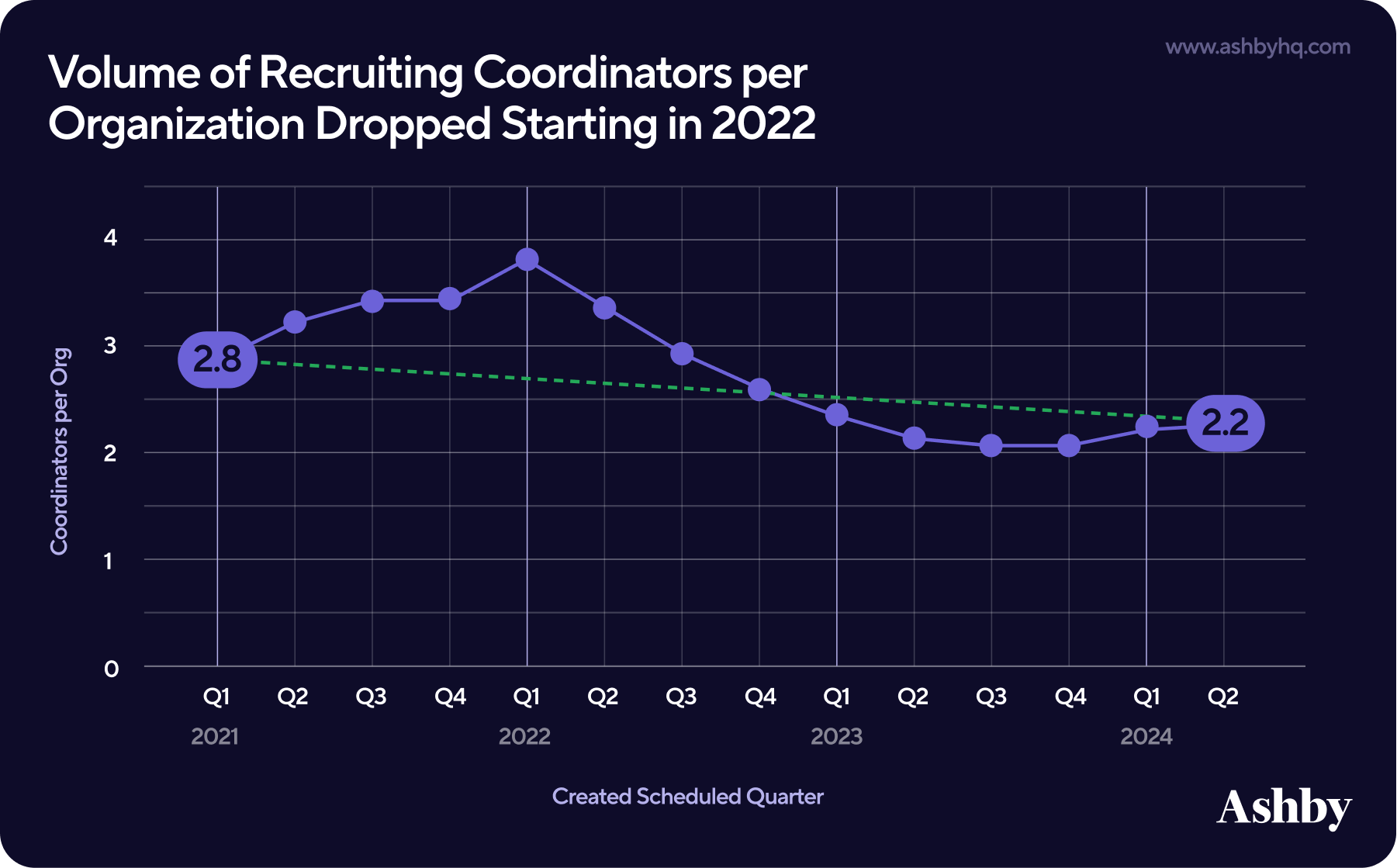
Volume of Interviews Scheduled per Organization Dropped in 2022 Alongside Volume of RCs on Team
To explore further, first we layered on scheduling activity to understand if changes in the number of coordinators on the team changes the output of scheduling work that is done.

Now we can see that there's been a downward trend in both Schedules Created per Organization and Coordinators Used per Organization. In other words, less scheduling is seen with fewer recruiting coordinators.
What didn’t experience as steep a drop is the Schedules per Coordinator, which has instead been rising over roughly the same time period. Overall, this matches the narrative we’ve seen in the market — reduced hiring and team sizes while expecting remaining staff to do more with less.
But as we saw in “No RCs in Org Structure,” not every recruiting team has coordinators, especially when looking at earlier stage startups. Given our data ranges from startup size to enterprise size companies, we took a further look at these same set of metrics by company size.
Specifically, we broke out the data by companies:
- 1-99 employees
- 100-500 employees
- 501-10,000+ employees
Companies With <100 Employees Relatively Flat Across Volume of RCs and Schedules
Starting with less than 100 employees, we can immediately see the metrics mostly flatten out with a slight downward trend starting in 2021 through the end of Q2 2024. Overall companies of this size are not following the overall trend line of downsloping utilization. A primary factor here could be that companies at a more startup size typically don’t have many recruiting coordinators to begin with — the chart below showing an average of ~1.4 between Q1 2021 and Q2 2024. [Tweet This]
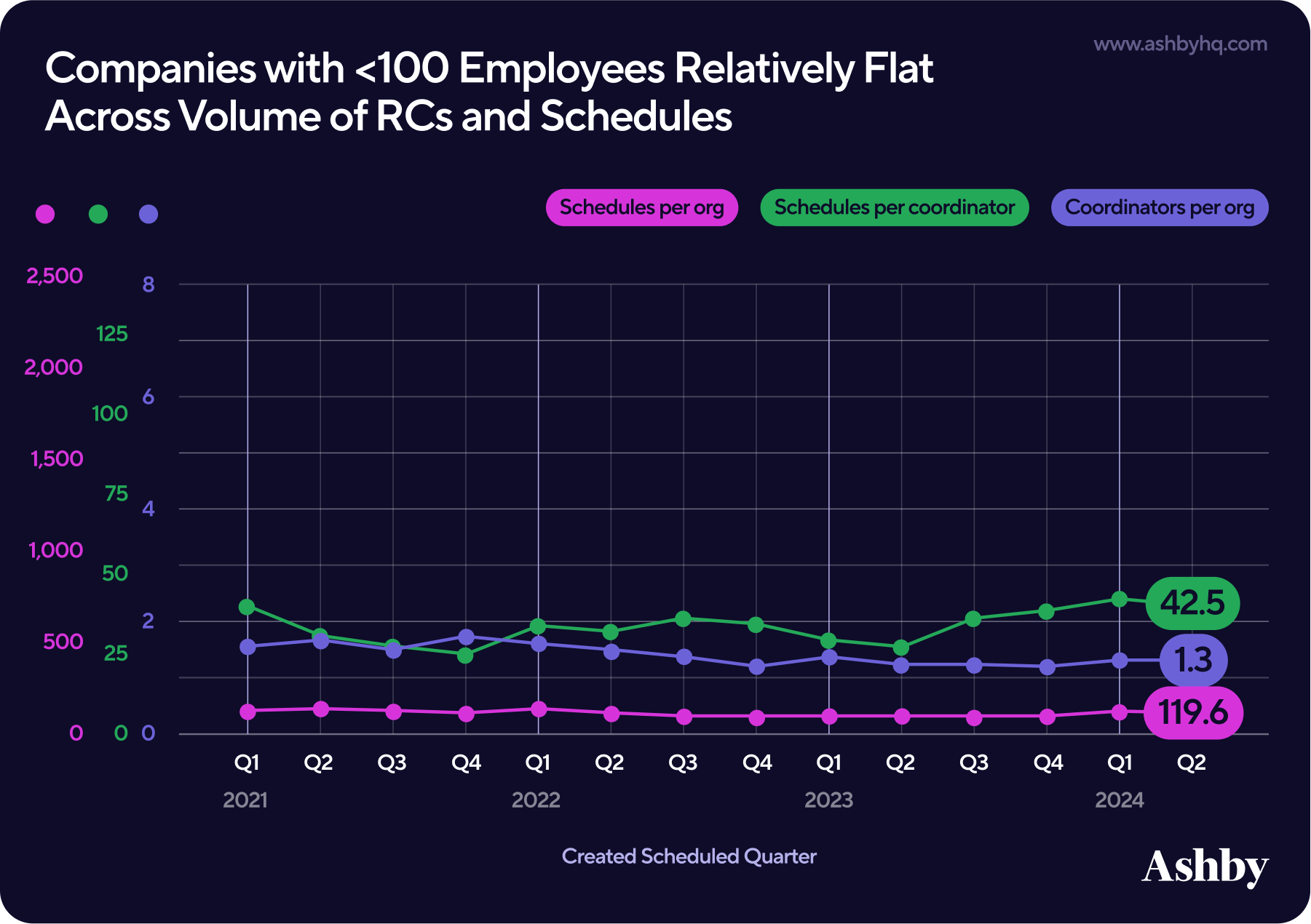
Companies Between 100-500 Employees Saw a Drop in RCs and Schedules Per Org Starting in 2022
Looking next at companies between 100 to 500 employees, we slowly start to see the downward global trend across all company sizes take some shape. Coordinators per Org and Schedules per Org begin to slope downward across 2022 and bottom out from 2023 to Q2 2024. Specifically, we see an entire headcount drop from 2021 to 2024:
- Between Q1 2021 and Q2 2022, companies with 100-500 employees saw an average of ~2.7 Coordinators per Org [Tweet This]
- Between Q3 2022 and Q2 2024, companies with 100-500 employees saw an average of ~1.7 Coordinators per Org [Tweet This]
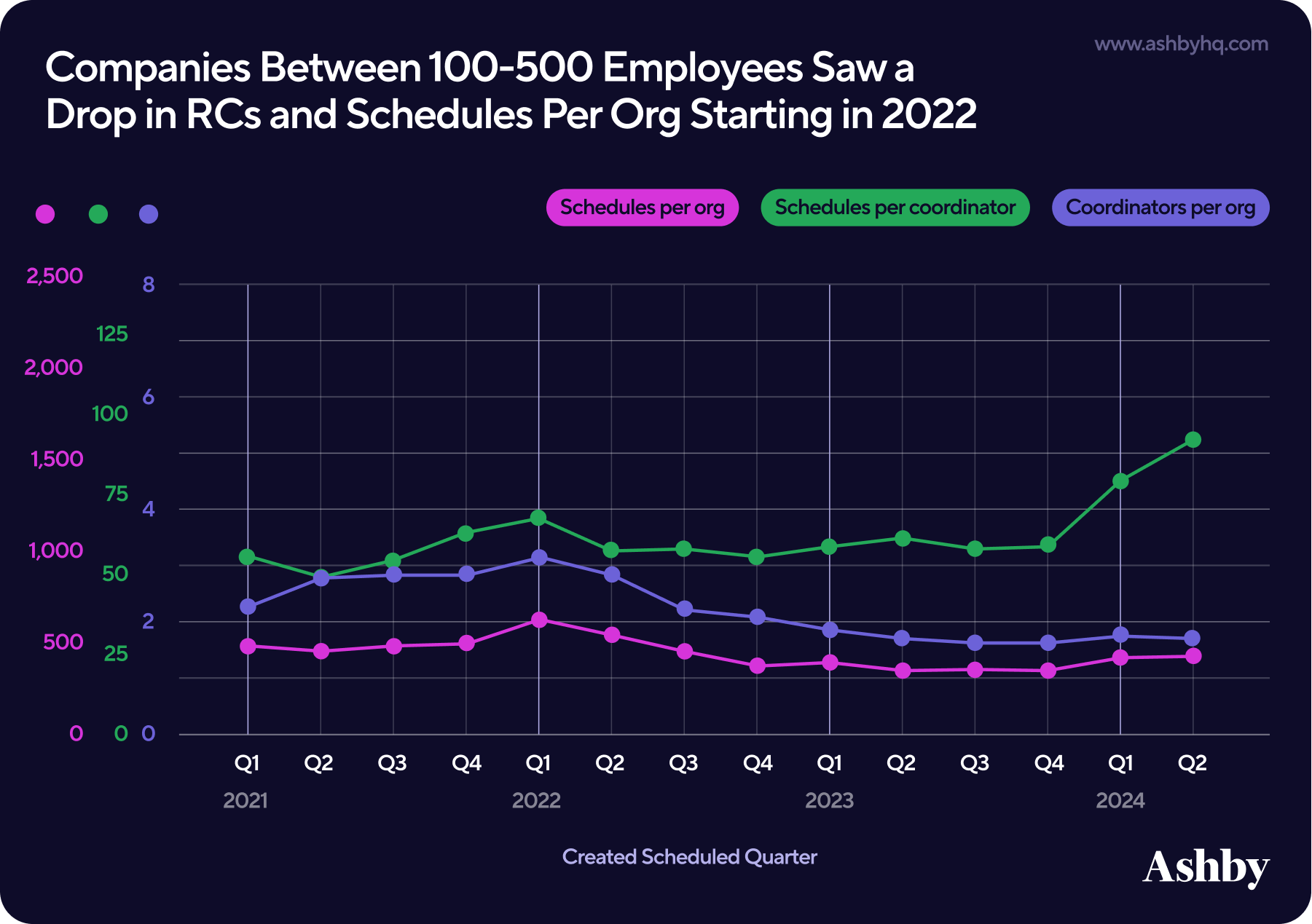
Meanwhile, Schedules per Coordinator begins to see a slight uptick at a few inflection points with a slight increase in 2024, signaling more work per coordinator over time. In other words, there was likely some downsizing in RCs on talent teams but when scheduling work picked up alongside hiring at different points in time, rather than hiring more RCs the extra work was distributed among the leaner team. Technology improvements in scheduling may be playing a part in making this more possible — which we’ll get to later in this report.
Reflecting on their six-person talent team at HackerOne, Marizza Clemente shared how tooling like Ashby enables them to scale coordination work efficiently with just her (team with one RC) handling the core responsibilities.
“With Ashby, it’s definitely doable. The ATS is efficient, easy, and user friendly. And since switching, we haven’t had any complaints about scheduling. We just get everything done!”
— Marizza Clemente, Talent Experience Partner at HackerOne
Ashby Scheduling 2.0
In April 2024, Ashby introduced Scheduling 2.0 to go beyond what has existed in traditional tools and meet the modern demands on lean TA teams to balance high volume scheduling with exceptional candidate experience. This update included:
- Core scheduling improvements focused on speed, candidate experience, and quality of interview outcomes released in Q1 2024.
- Our new Advanced Scheduling Automation Add-on with AI-powered auto-scheduling, interviewer training, Scheduling Requests, and more.
Learn more detail about each feature on our product blog.
Companies with 501-10,000+ Employees Experienced the Sharpest Drop in RCs Org in 2022
And finally, companies with over 500 employees. This is where we really see the global trend exaggerated for Coordinators per Org, which could imply that larger orgs bias the trend line here quite strongly. These larger companies often have more coordinators as well as more coordination work to be done, as visualized by the Schedules per Org picking up again in 2023 after dropping throughout all of 2022.
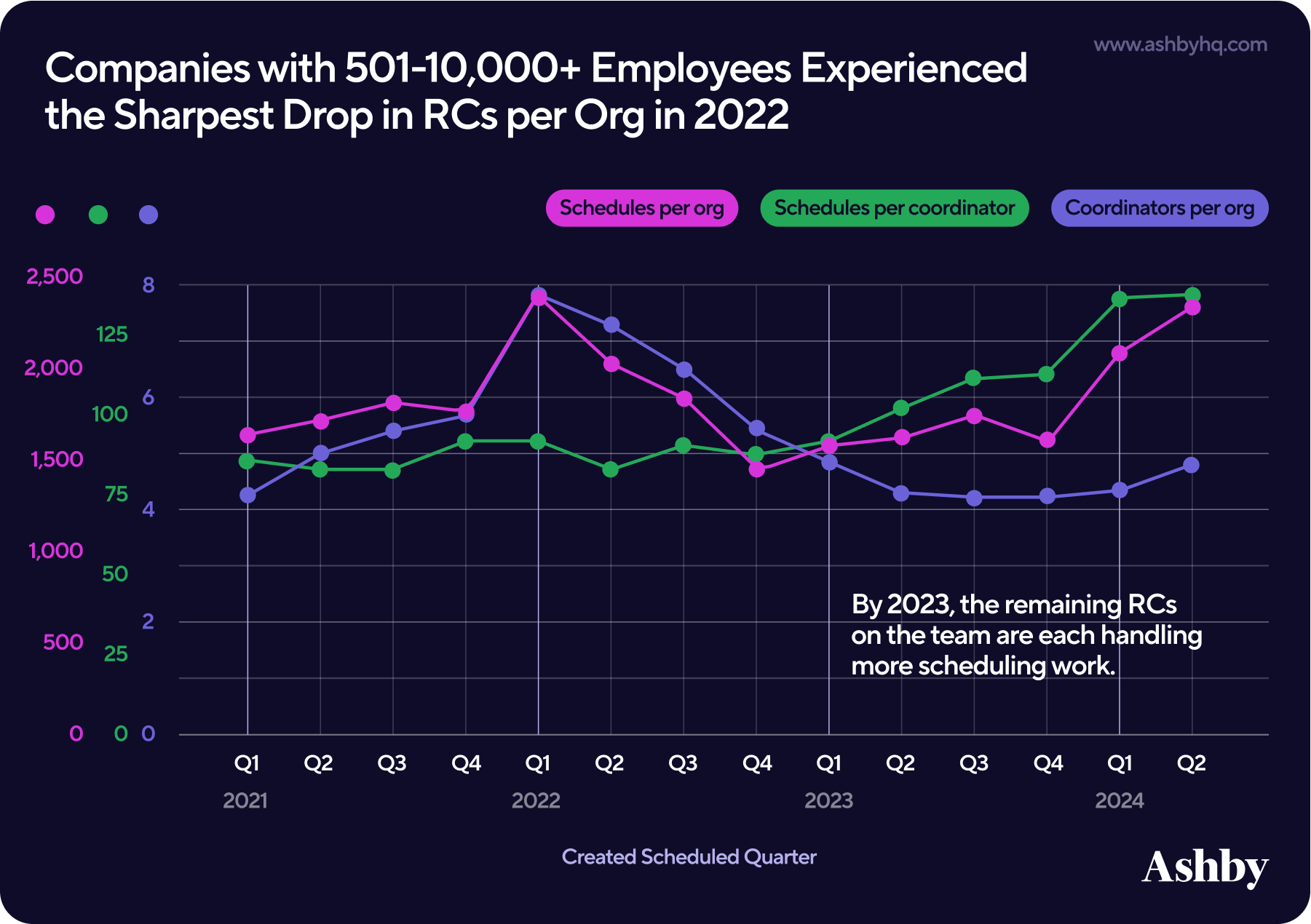
Q2 of 2023 is also where we see Schedules per Coordinator begin to rapidly pick up, signaling coordinators at larger orgs are being asked to do much more scheduling work per coordinator. To help paint this picture, we pulled out the data into a table for the start of each year analyzed to highlight the exaggerated workload at various points in time.

Recruiting Coordinators, on average, supported ~4 Recruiters between Q1 2020 and Q2 2024
Given the changing organizational structures of recruiting teams, we wanted to explore the ratio of Recruiters to Recruiting Coordinator. We did so by looking at the number of recruiters that an RC supported by scheduling interviews. Here we can see:
- Recruiting Coordinators, on average, worked with ~4 Recruiters between Q1 2020 and Q2 2024.
- The number of recruiters that an RC works with went down between the start of 2021 and end of 2022, from ~5 to ~4. [Tweet This]
- While this trended up slightly in 2023, overall RCs have fewer recruiters to support than seen in 2020 through most of 2021 (down roughly one recruiter to support). It’s worth noting that the end of 2021 was when many companies were rapidly hiring.

This doesn’t necessarily imply that there has been an intentional improvement in the ratio of RC:Recruiter support. From other studies and sources, it’s possible that there are simply smaller recruiting teams amidst industry layoffs, which naturally led to fewer recruiters on talent acquisition teams. Or, with the “No RCs in Org Structure” scenario aforementioned, some teams are rethinking the design of their teams.
“With Ashby Scheduling, we get to think really creatively about our recruiting function. We’re very, very intentional about our white glove service and where we’re going to have those important, human touch points. It also aligns with the mission of Multiverse and is the mindset of, let’s give people a meaningful career path that isn’t just scheduling. How do we in four to six months of them being in seat get them to hop, skip, or jump to a bigger recruiting challenge?”
— Veronica Salcido, former Head of Global Talent at Multiverse [Case Study]
Connecting the dots between all the findings so far, we’re starting to see that overall — particularly in 100+ sized organizations — the ratio of RCs per recruiter is down while the relative work remains the same. More specifically, the total number of RCs per Org as well as the average number of an RC works with.
RC Weekly Scheduling Range
All that said, in speaking directly with Heads of Talent, we often heard that teams scope the number of coordinators to have on a team by scheduling capacity. Given the variation in number of coordinators, schedules, and schedules per coordinator by organization size seen earlier, we observed this by scheduling range to understand what volume can look like more holistically. As seen in the table, the bottom 25th percentile shows coordinators managing 14 schedules per week while the 90th percentile shows coordinators handling 47 schedules per week. This percentile breakdown takes into account the varying scheduling workload, interviewing process, or hiring goals week-to-week.

Part 2: Stages of the Coordination Process
When we first mapped out the various responsibilities associated with coordination roles, it wasn’t the easiest to simplify. We started with this view:
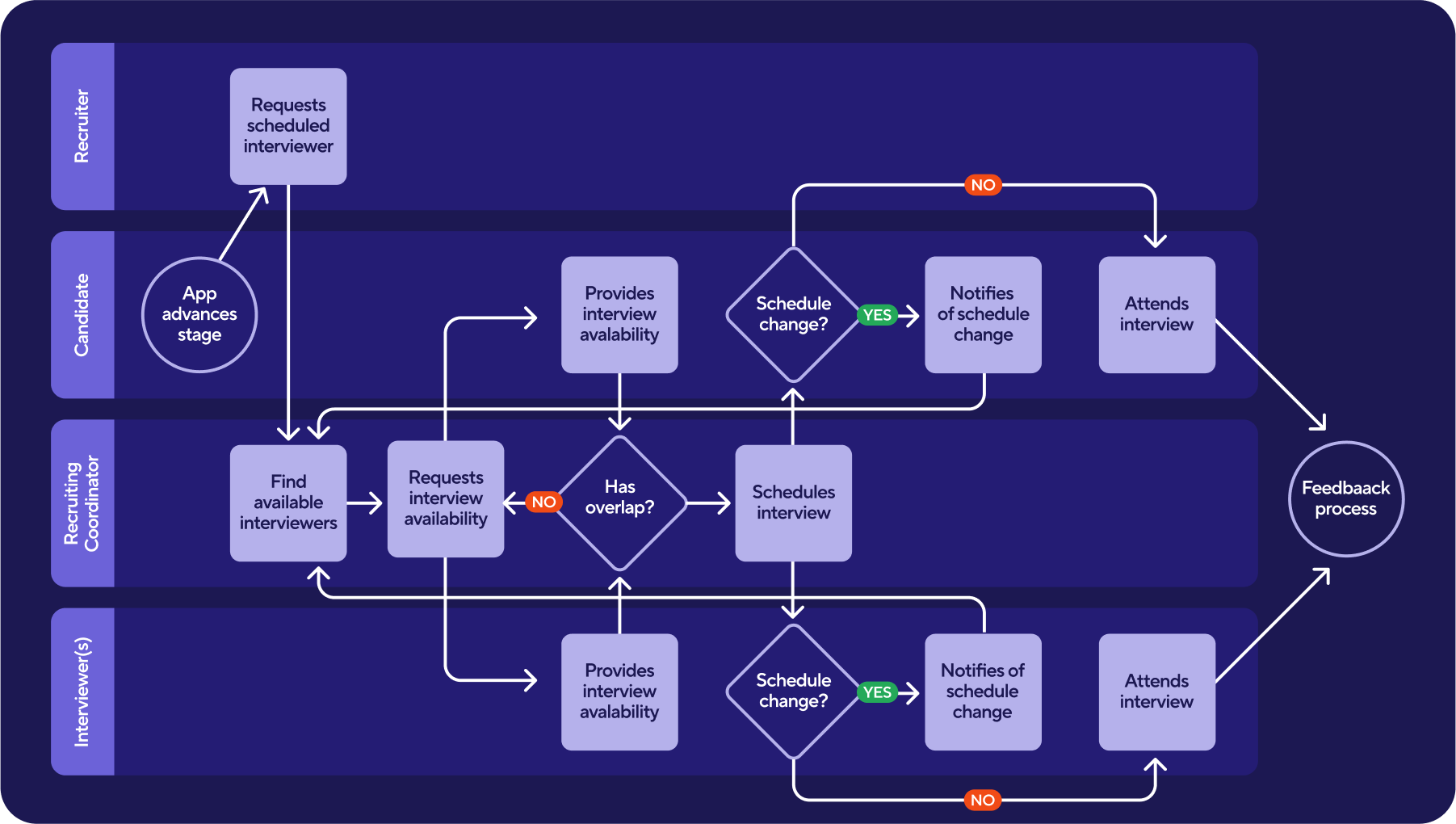
As illustrated, a number of variables can affect progress and movement. There’s also an impressive amount of work that happens behind-the-scenes that potential candidates, hiring teams, and other stakeholders outside recruiting may not always see.
If we zoomed out further, we could see that the coordination work overall sits in three high level buckets:
- Single Event Scheduling: Recruiter Screens, Hiring Manager Screens
- Onsite Coordination: Panel Interviews, In-person Onsites
- Assessment and Debriefs: Scorecards, Experience Surveys
Let’s understand each bucket through the data we analyzed.
1. Single Event Scheduling
Let’s begin by understanding who is doing the scheduling.
Recruiters are Associated with the Majority of Schedules Created
Depending on the size and makeup of your talent acquisition team as well as stage of interview, it’s not always RCs behind scheduling. We took a look at the proportional count of interviews scheduled by role within the organization. The shifts in who is responsible are minimal.
- Recruiters are associated with the majority of schedules created (an average of 70%)
- Recruiting Coordinators are associated with roughly 26.1% of schedules created [Tweet]
- Hiring Managers are associated with roughly 3.7% of schedules created
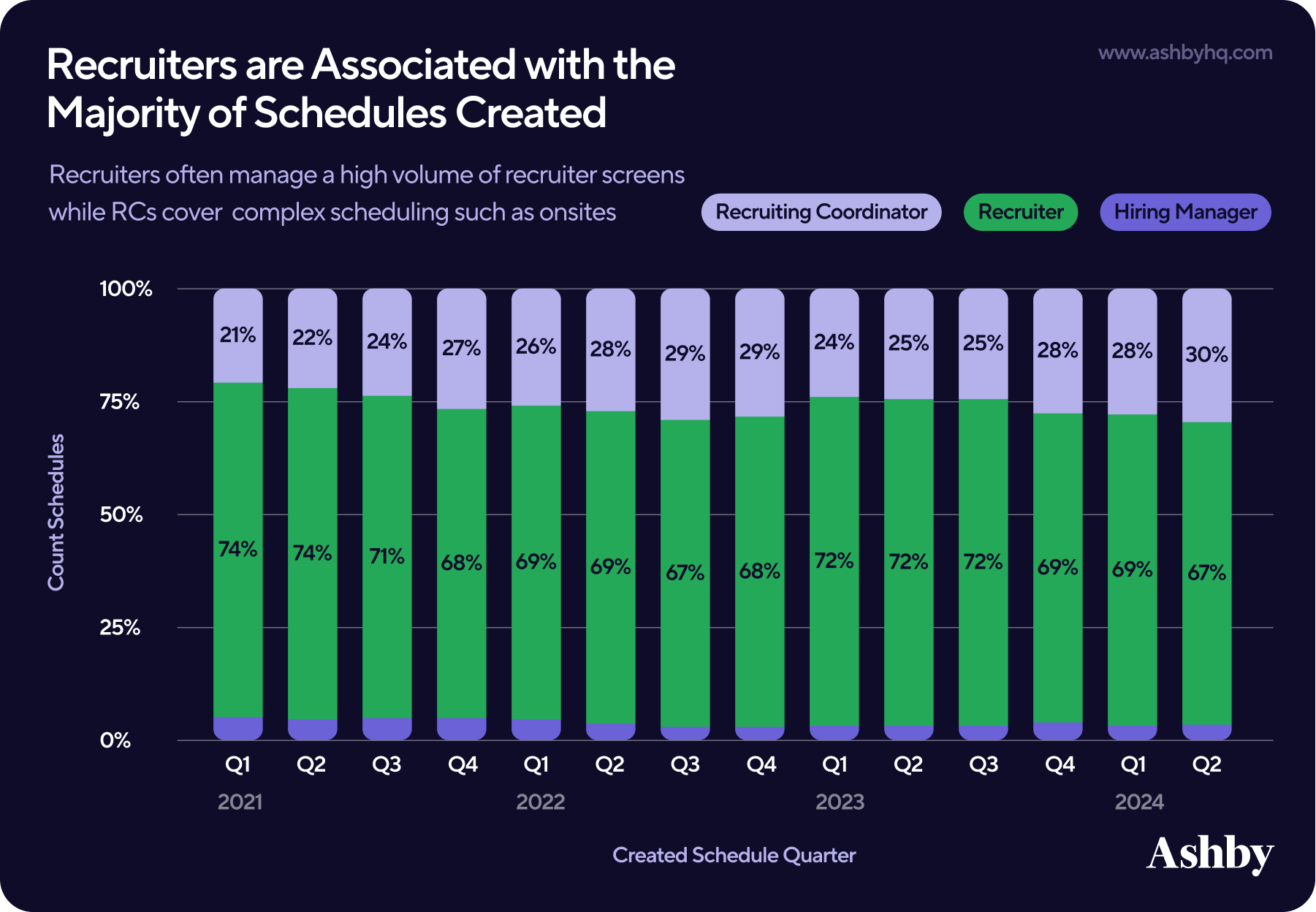
By nature of where scheduling happens across interview stages, these buckets make sense. Recruiters often handle the highest volume of recruiter screens and the scheduling that goes along with them. RCs instead come in most often to handle scheduling conflicts, coordinate multiple team member calendars, and overall more complicated scheduling (such as panels or onsites).
We can see this illustrated further in this next chart, showing that:
- For single event interviews, recruiters manage 76% of schedules and RCs 21%
- For multi-event interviews, recruiters manage 21% of schedules and RCs 67%
In other words, while coordinators tackle more complex stages of the interview process, they still support scheduling activity across the funnel.
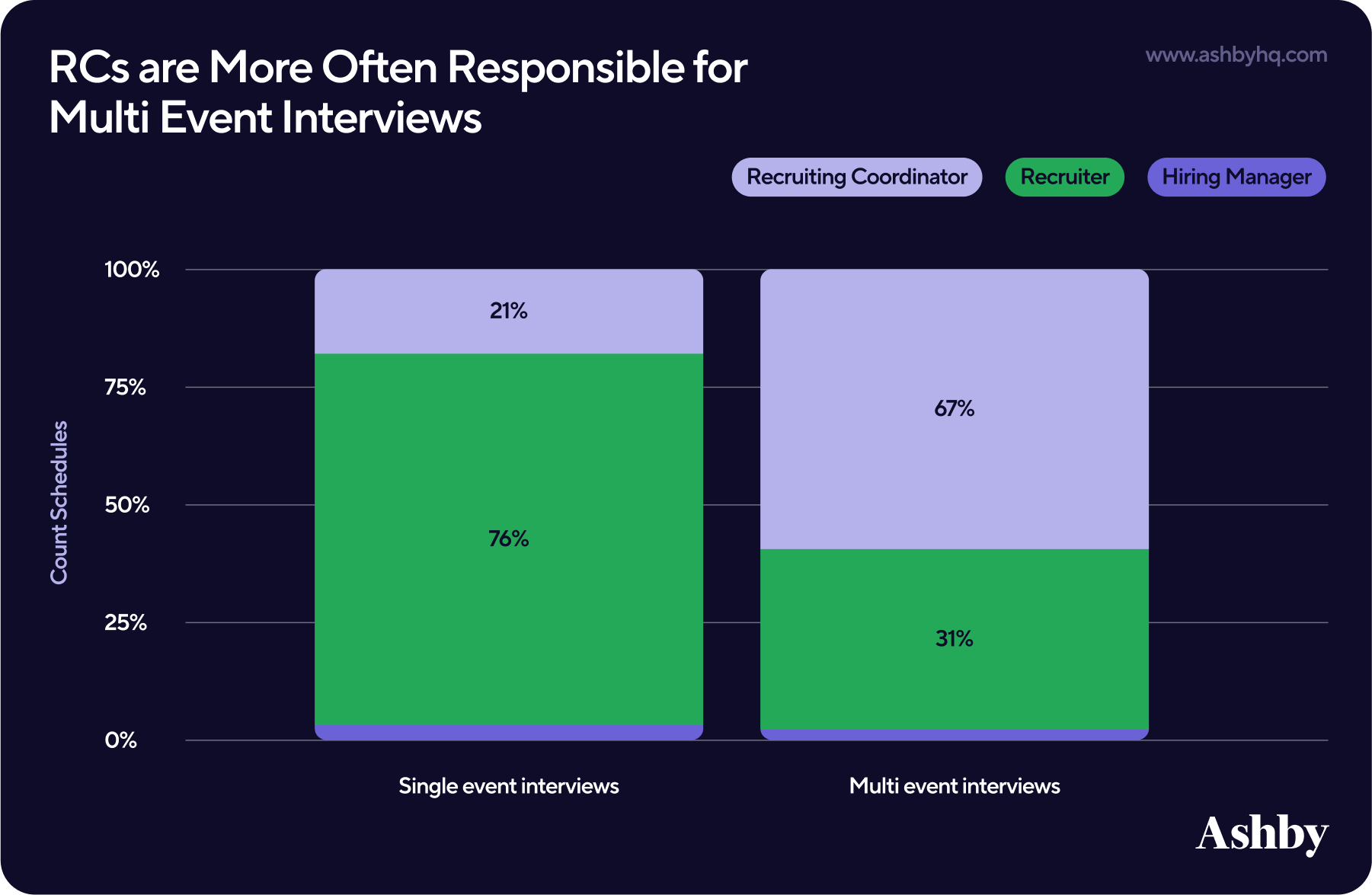
50% of Candidates Provide Availability within 24 Hours
The very first step in any interview process begins with requesting candidate availability.
Unsurprisingly, our data shows that the vast majority of candidates provide their availability within 24 hours of the request being sent. This trend means that the biggest opportunity for faster coordination (if that’s a goal for your organization) is in the time between when the events are scheduled and when the first event begins (which we’ll look at next).
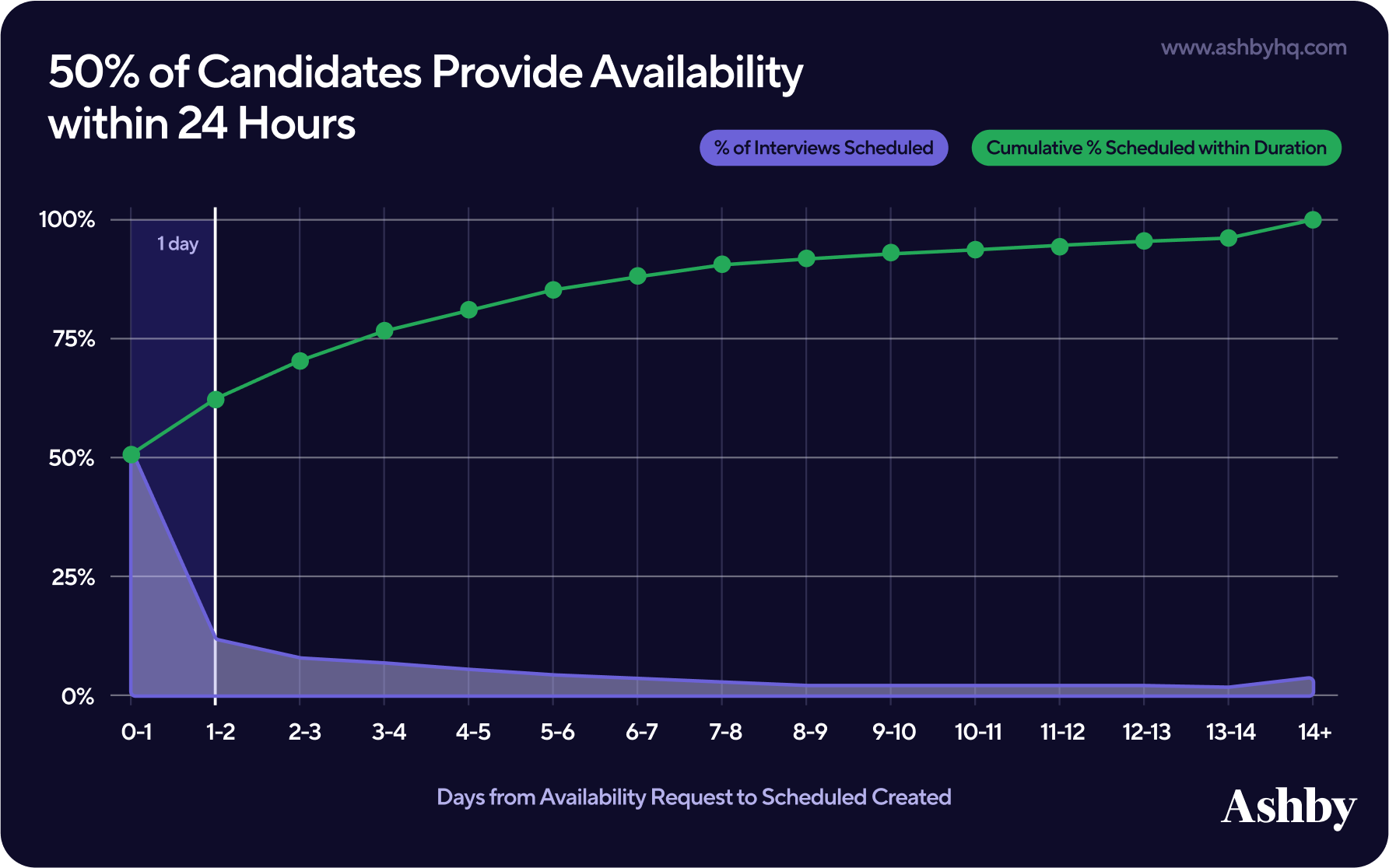
[🕒Efficiency Tip]
“The little things make such a big difference. I love being able to request availability right from a button click on the [Ashby] candidate profile — our previous ATS didn’t have this feature. That alone saves me 3-4 clicks, or a minute of my time. And then if you multiply that by 10 candidates, that's 10 minutes saved, which compounds significantly over the course of a week. And then on top of that, having all the communications around scheduling in one view. Altogether it gives me back time to take on other work (in my case, new hire onboarding).”
— Angelita Yarborough, Senior Recruiting Coordinator at Ironclad
~65% of Candidates Completed Interviews within a Week of Availability Request
Here we looked at the number of days between when availability is requested and when the scheduled interview happens. We observed that:
- ~65% of candidates go from an availability request to the first interview completed within a week.
- The majority of interviews are completed within two weeks of requesting availability.
- The last 8-10% linger in a time period beyond two weeks.
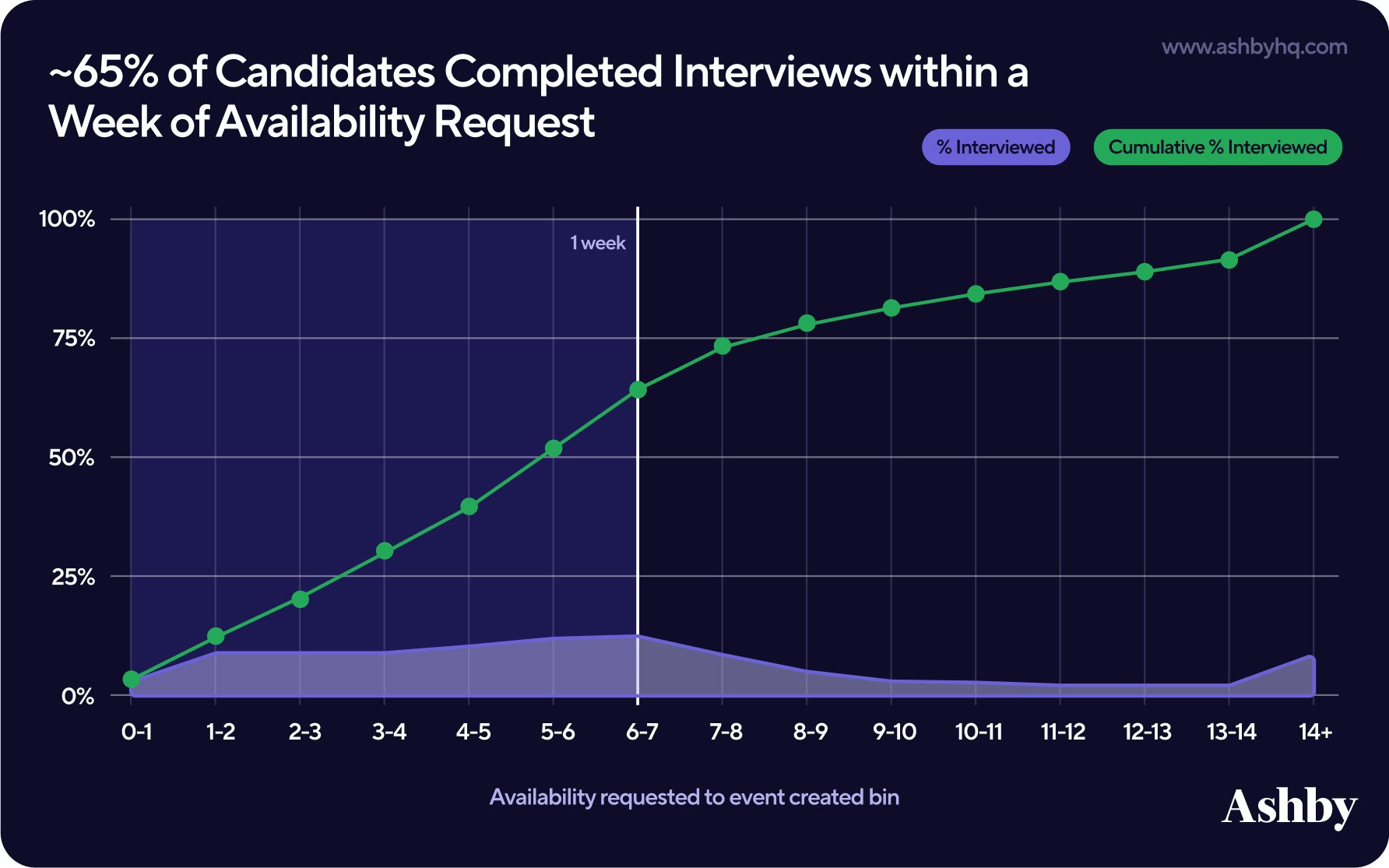
One of the common pain points we keep hearing for streamlining scheduling often boils down to time management (and wasted hours) converting time zones.
[🕒Efficiency Tip]
“Before Ashby, just to schedule one person, I’d have to open a timezone converter and go back and forth between screens. It took me up to 15 minutes in our legacy ATS and I’d get lots of complaints from candidates and hiring managers about things showing up at the wrong time. In Ashby, it takes max five minutes — and that’s for more complicated interviews. Ashby converts time automatically for you and makes syncing calendars thoughtless. We don’t get complaints anymore.”
— Marizza Clemente, Talent Experience Partner at HackerOne
Interviews Start a Median 6 Days After Availability is Requested
When looking at the data again by median days, we found that it typically takes five days (inclusive of weekends) from the time availability is requested to when the interview starts. In other words, there’s about a 6-day lead time from availability request to interview start.
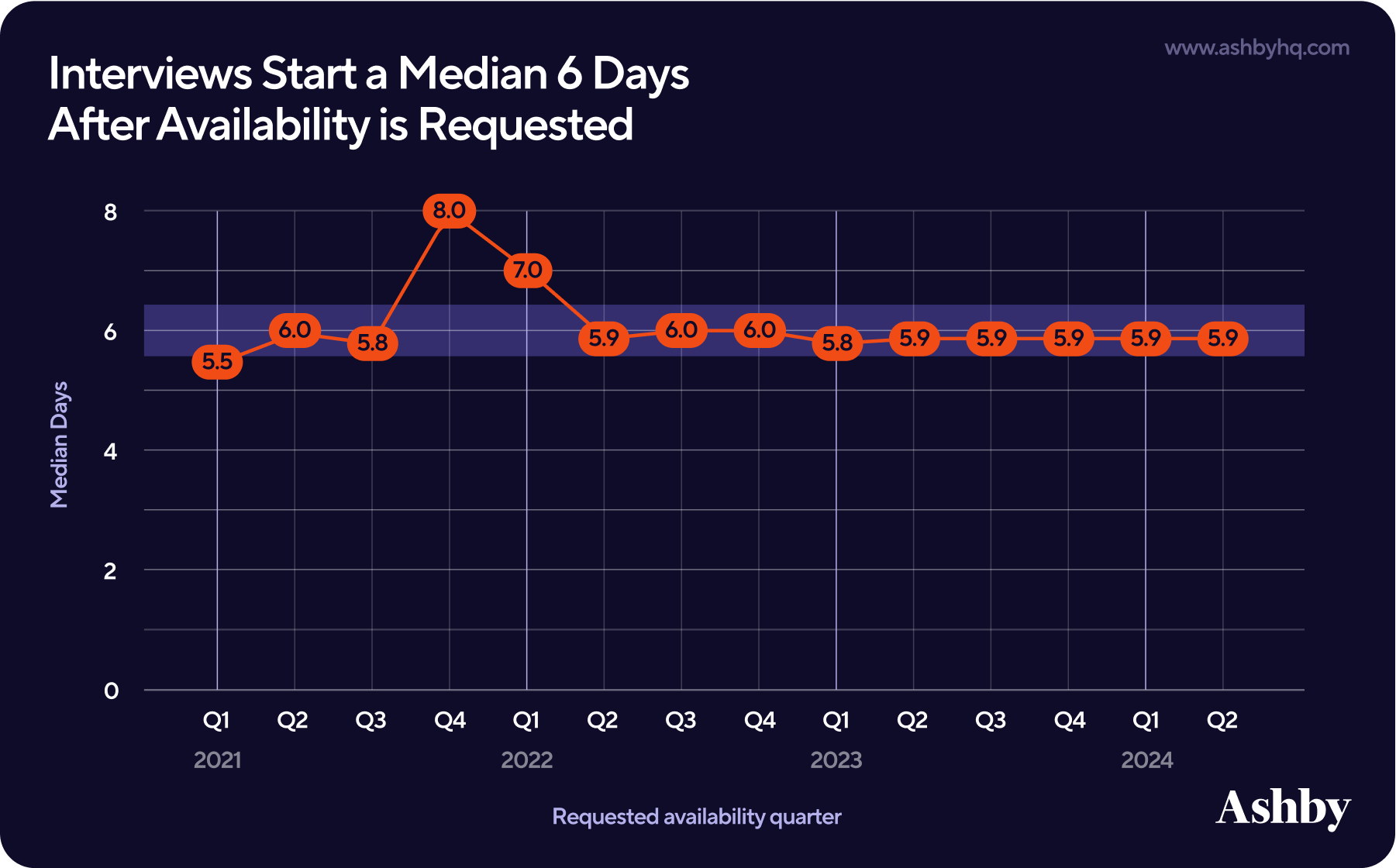
[🕒Efficiency Tip]
“We used to manually track who is being trained for interviews, who is ready, etc. One of the nice things about Ashby is automatically having a pool of interviewers that serve as backups when cancellations or reschedules occur, so with just a click we can swap in someone who is ready and available at the time slot.”
— Angelita Yarborough, Senior Recruiting Coordinator at Ironclad
2. Onsite Coordination
Unsurprisingly, single-event interviews (such as a recruiter screen or 1:1 interview with candidate and hiring manager) most often occur before panel interviews. There is inherently more coordination effort and organizational skills involved in panel interviews.
Panel Interviews Often Occur a Day Later Than Single-Event Interviews
As we noted earlier, about 50% of interviews are scheduled within a day of receiving availability. However, if we break that metric out by single event vs panel interview scheduling, we find:
- 54% of single-event interviews are scheduled within 1 day (excluding direct booking, which we discuss in the final section of this report)
- 34% of panel interviews are scheduled within 1 day
Overall, we see a substantially lower proportion of panels being scheduled quickly. Let’s look at this through an example. A coordinator emails a candidate for a Hiring Manager screen. From the day that availability is requested to when that screen happens could be as short as a day given the limited calendar complexity or desire to move along the process. If a coordinator was instead requesting availability for a panel interview, the candidate may desire more time to prepare while the RC needs to manage more calendar availability, leading to a multi-event interview occurring a day later.

Of course, one of the primary reasons time-to-schedule can go off track is also one of the most common fires an RC deals with: reschedules or cancellations. We heard from many coordinators that rescheduling can eat up chunks of time — especially when it’s part of a panel interview.
[🕒Efficiency Tip]
“Historically when I received a cancellation, I’d have to email the entire team, click into the entire interview plan, get creative with how to delete the one affected interview without messing with the entire panel because most tools typically notify all interviewers. So then I have to go back to Gmail and email everyone on the panel who is not affected to let them know nothing has changed and their interviews are still on. Now with Ashby, I’m able to select the specific interview to cancel, choose only those interviewers affected, and email the entire panel at once right from the tool.”
— Angelita Yarborough, Senior Recruiting Coordinator at Ironclad
3. Assessments and Debriefs
Across every interview step, ensuring scorecards are in to make important decisions on who is moving along the hiring process is vital.
Most Feedback Scorecards are Submitted within 2 Hours
To start, we defined two important metrics here:
- Scorecard Submission Rate: the proportion of scorecards that were submitted before the application's next stage change
- Hours to Submission: the duration in hours from the moment at which the interview event ends to when the interviewer submits their scorecard
We found that:
- Both Scorecard Submission Rate and Hours to Submission remained flat at a global level between Q1 2021 and Q3 2024.
- Average submission rates for scorecards were between 84 to 89%, with the majority of feedback being submitted within a median of two hours. [Tweet This]
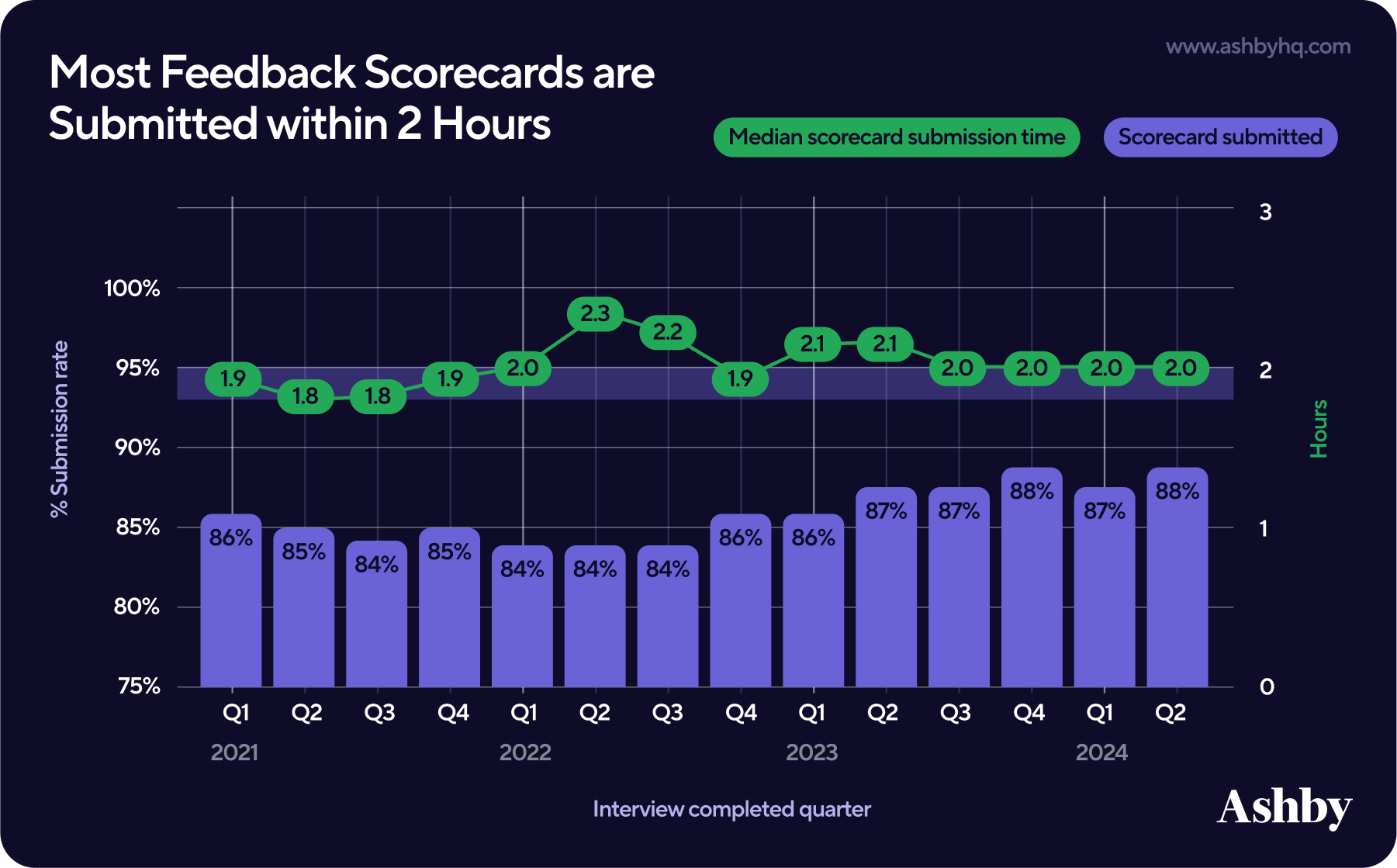
Legacy ATSs Experience 21% Slower Scorecard Submissions than Ashby
Anecdotally, we’ve heard how difficult it can be for some talent teams to ensure feedback is submitted both within the required timeframe and with the required information to make hiring decisions. Ashby’s philosophy here includes making the process of accessing the scorecard as quick and simple for hiring teams as possible to increase the odds of submission.
As such, we sought to break out that earlier 84-89% submission rate by those using Ashby as their primary applicant tracking system (ATS) versus a Legacy ATS. We found that users of Ashby submit ~7% more scorecards with an average submission time that's ~17% faster. In other words, legacy tools experience 21% slower scorecard submissions. [Tweet This]
More specifically, Ashby users:
- Experience higher completion rates averaging 90%
- Submit feedback within a median of 1.9 hours
Legacy ATS users:
- Experience scorecard complete rates closer to 84%
- Submit feedback within a median of 2.3 hours

Ashby Users: You can check your company’s completion rate through the Interviews Dashboard. “Feedback Completion Rate” covers the last 12 months of all interviews while “Feedback Completion by Interviewer” lists the total interviews, feedback completed, completion rate and the average time to submit by each interviewer. Learn more here.
Part 3: Where New Technology Drives Efficiency
Recruiting coordination is the one area of recruiting ripe for the most efficiency gains with thoughtful automations.
Interviews Get Scheduled 33% Sooner with Direct Booking Links
Earlier we uncovered how single-event interviews can be scheduled up to a day faster than panel interviews. Given Ashby’s Direct Booking Links feature, we wanted to explore how much automated scheduling plays a role in this faster turnaround.
Turns out that:
- With Ashby’s Direct Booking Links, 72% of single event interviews get scheduled within one day of requesting availability. [Tweet This]
- Without Ashby’s Direct Booking Links, 54% of single event interviews get booked within a day of requesting availability.
The latter could signal the human time element involved with manually getting availability collected and shared with a candidate.

In other words, interviews get scheduled 33% sooner with Direct Booking Links. Direct Booking Links are one of a variety of advances made in the realm of scheduling tools for recruiting.
Ashby Direct Booking
Direct booking links can be sent to candidates so they can view the panel’s availability. They can then select a suitable date and time and schedule their interview directly.
Direct Booking Links can be sent when:
- The interview activity only has one interview event.
- There are less than ten potential interviewers who could be on the panel.
Learn more on Ashby University or book a demo to learn about Ashby scheduling as a whole.
Scheduling with Ashby Can Help Schedule Candidates ~1.5 Day Faster than Legacy ATSs
Regardless of Direct Booking Links, we found that talent teams can schedule interviews over a day faster with Ashby than legacy ATS providers. Specifically:
- It takes 4 days from the point an interview event is created (aka there’s a candidate needing scheduling) to getting that interview scheduled.
- It takes 5.6 days to do the same in a legacy provider.
In other words, scheduling is, on average, 40% faster in Ashby than legacy tools. [Tweet This]
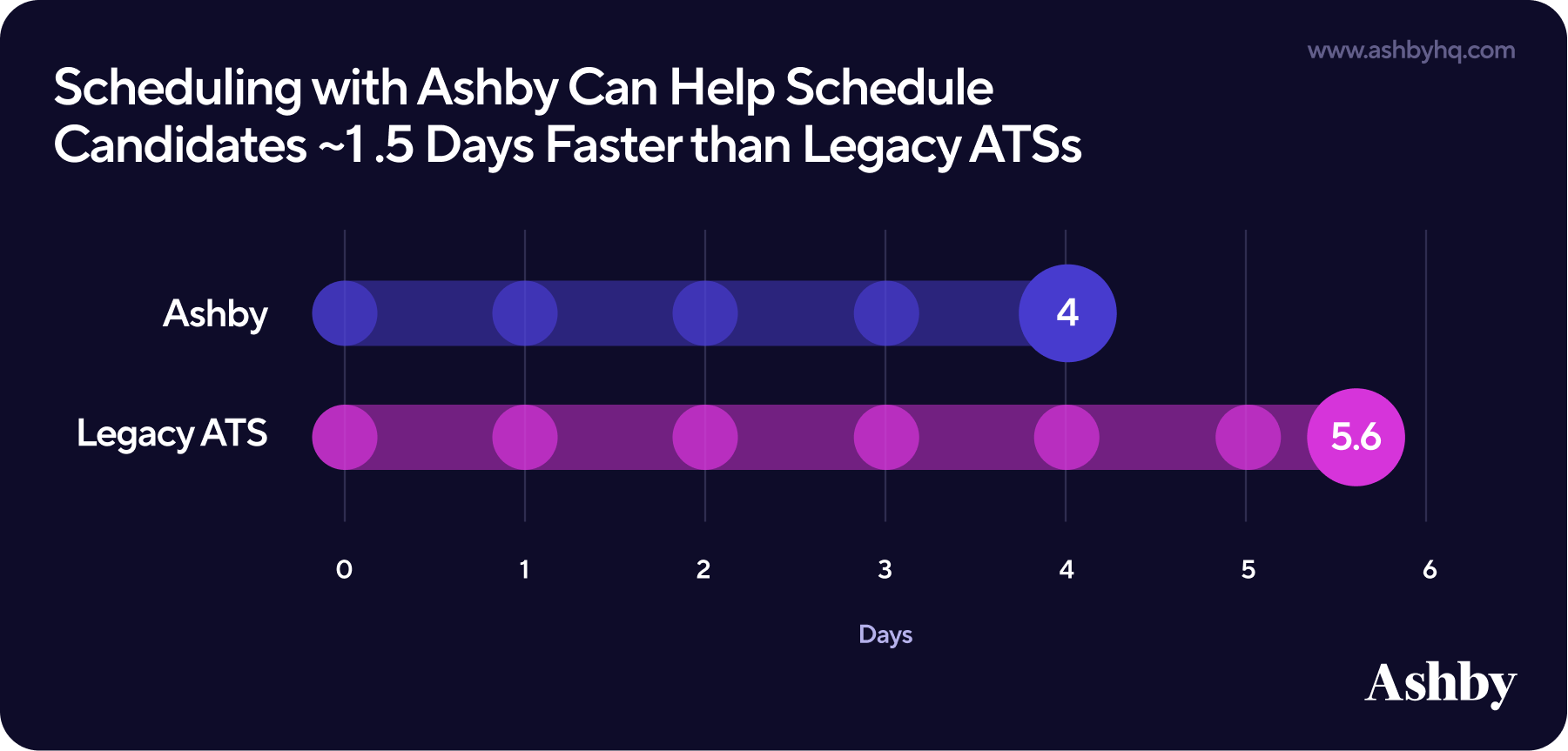
“We have always had a 24-hour SLA — though we try in most cases to respond the same day. Ashby makes this a lot easier to accomplish. There’s one view of all scheduling activity and pulls up anything that requires attention. I can see that a candidate submitted availability 5 hours ago, know what needs attention by the end of my day, and schedule without having the invite go out right away. This allows us to hold calendars with interviewers while we figure out the entire panel schedule.”
— Angelita Yarborough, Senior Recruiting Coordinator at Ironclad
The Human Element of Coordination
While technology is rapidly improving the speed at which anyone dealing with coordination within a recruiting team can get things done, some parts of the process require more human oversight than others.
“It’s nice to have email templates for things that are repetitive, but things happen. Sometimes a candidate reaches out to cancel an interview because someone in their family is sick. I wouldn’t want to send a template in that situation, and instead have that real, human interaction to show we care and help them feel secure in having to request a change.”
— Angelita Yarborough, Senior Recruiting Coordinator at Ironclad
Often, the time saved through new scheduling advancements can be reallocated to further improve the candidate experience.
“Later in the hiring process when we’ve chosen a candidate, we prefer not to automate letting the other late stage candidates know. We want to connect directly with the candidate at that point, thank them for their time, and explain the end result. It’s important to have time for these human touchpoints.”
— Marizza Clemente, Talent Experience Partner at HackerOne
Conducting an Interview without Sufficient Notice Could Increase Pass Rates
While speed and efficiency are important to any recruitment process, speed must be balanced with quality — often driven from the people involved. As we dug deeper, conducting an interview without sufficient prior notice can potentially inflate pass rates.
For example, interviews conducted with one day of notice see a 68.2% passing scorecard rate while interviews conducted with seven days of notice see a 63.2% passing scorecard rate. A passing rate in this context is a score of 3 or 4 (Ashby scores candidates on a 1-4 scale).
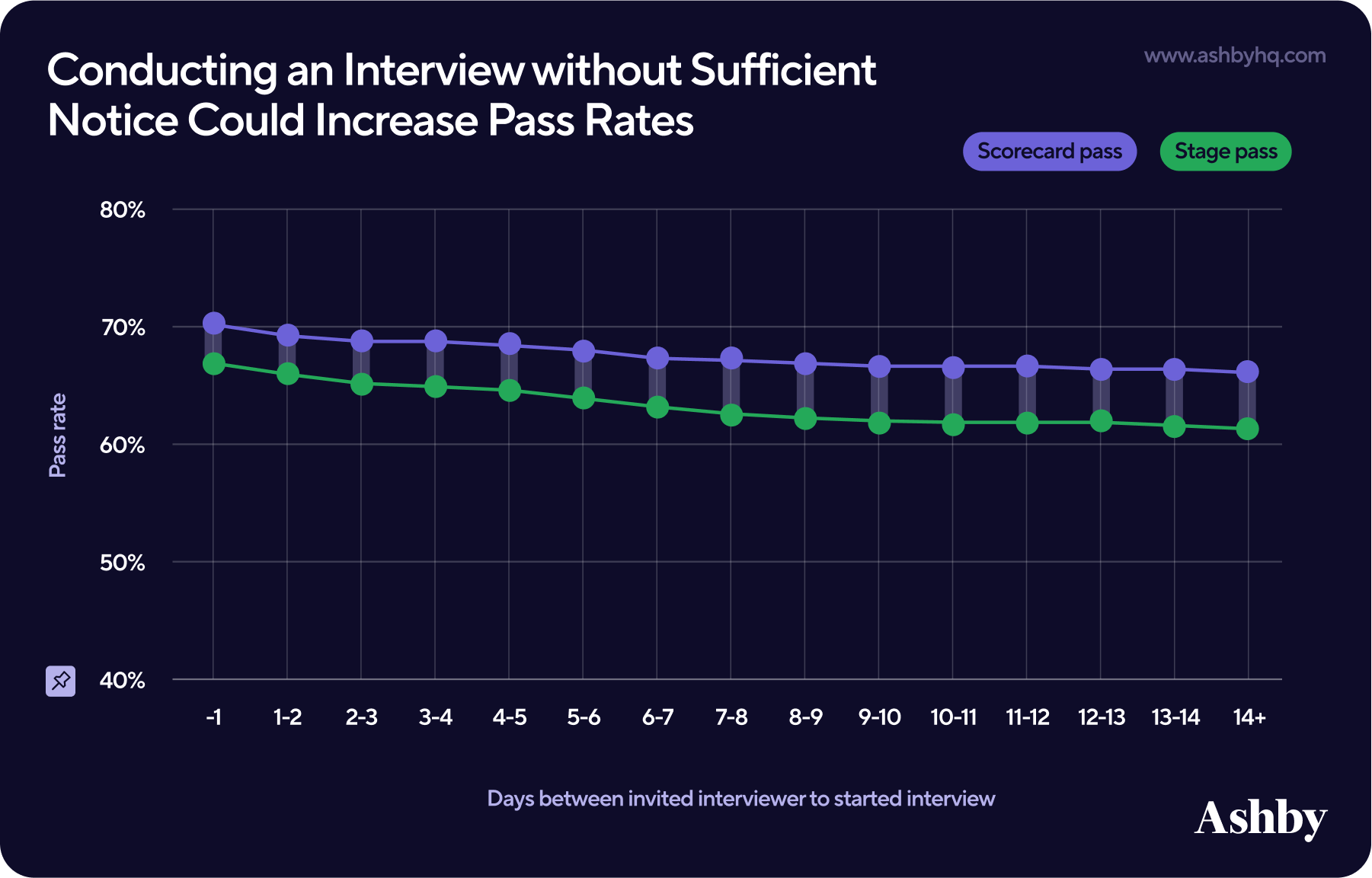
Conclusions
Through analyzing scheduling for over 2.8M candidates across 5.1M+ interview events, we ultimately found:
- Technology is helping streamline speed and efficiency in many areas of traditional coordination work, such as Direct Booking Links helping 72% of single event interviews get scheduled within one day of requesting availability.
- Scheduling with Ashby can help schedule candidates ~1.5 days faster than legacy systems.
- Panel interviews often occur a day later than single-event interviews, with panel interviews requiring the most human involvement.
We hope these insights help talent teams navigate, evolve, and inform their recruiting coordination strategy. For more recruiting insights and benchmarks, subscribe to our Talent Trends newsletter.
Other Reports
Recruiter Productivity | 2025 Talent Trends Report
An analysis of 31M applications and 95K jobs from January 2021 through September 2024 provides an inside look at shifting recruiter priorities.
Offer Acceptance Rates | Talent Trends Report
We analyzed Offer Acceptance Rate (‘OAR’) patterns over a three year period to share valuable insights and benchmarks for talent teams.

Subscribe for more talent trends and insights
We will be regularly releasing new reports around trends and insights we're seeing in our data and you will be the first to know.